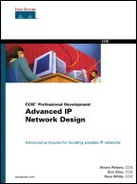Case Study: Route Reflectors as Route Servers
Sometimes route reflectors are confused with route servers (and vice versa). Route servers are generally used at Internet exchange points. The objective is for routers to only peer with the route server (not all the other routers in the exchange) and obtain all the routing information from it. The route server has the capability of propagating information in a transparent fashion—as if the advertisements were received directly from the router originating it.
Route reflectors also try to reduce the number of peers needed in an iBGP cloud, whereas the route server is typically used with eBGP neighbors. The route server itself processes no traffic, whereas the route reflectors do. In fact, route reflectors are usually placed at traffic aggregation points. It is clear that route reflectors and route servers satisfy different needs in the network.
Figure 8-6 illustrates a place in the network where a route reflector may be used as a route server.
Figure 8-5. Dual Connections into Reflectors

Figure 8-6. Route Server

Router A is the route reflector, and it peers with all the other routers on this shared media. The other routers don't peer among themselves. Note that the route reflector is a "router on a stick." In other words, it only has one interface. (This is not necessary, but it makes the example clearer.) All the routes reflected would have a next hop that is reachable through one of the other routers so that Router A will not process the data packets. Keep in mind that the route reflector doesn't change the attributes in the prefixes.
To illustrate this, assume that an external route is learned through Router B. The route is propagated through Router A (the route reflector) to Router E (and all the other clients). This is what the prefix looks like from Router E:
E#show ip bgp 30.0.0.0
BGP routing table entry for 30.0.0.0/8, version 7
Paths: (1 available, best #1)
200
200.200.200.2 from 10.105.1.71 (200.200.200.1)
Origin IGP, metric 0, localpref 100, valid, internal, best
Originator : 200.200.200.1, Cluster list: 140.10.245.1
E #show ip route 200.200.200.2
Routing entry for 200.200.200.0/24, Hash 196
Known via "isis", distance 115, metric 20, type level-1
Redistributing via isis
Last update from 10.105.1.76 on Ethernet0, 00:04:25 ago
Routing Descriptor Blocks:
* 10.105.1.76, from 200.200.200.1, via Ethernet0
Route metric is 20, traffic share count is 1
Note that the prefix was learned from the route reflector (10.105.1.71), but the next hop is reachable via Router B (10.105.1.76). In this case, the traffic destined for 30.0.0.0/8 will be forwarded directly to Router B from Router E without going through the route reflector.
